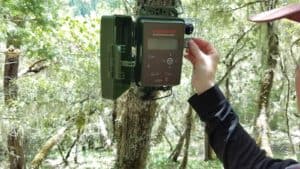Share this article
Listening in to help monitor northern spotted owls
By listening to sounds collected from recording devices in the forest, researchers can detect northern spotted owls and invasive barred owls, which can help with monitoring and conservation efforts for the former.
Federally threatened northern spotted owls (Strix occidentalis caurina) in the Pacific Northwest first faced habitat loss from logging before barred owls moved in and began competiting with them. “We got the habitat situation under control, but the barred owl population is increasing, and spotted owls continue to decline,” said Leila Duchac, a postgraduate researcher at Oregon State University. The Northwest Forest Plan helped slow down habitat loss from timber harvest on federal lands, but some habitat is still declining from harvest on nonfederal land and wildfires are also causing downward trends in some areas. Barred owls (S. varia) compete with the northern spotted owls for resources and habitat. “It’s often really difficult to find spotted owls on their historic territory.”
Past monitoring efforts, which have been taking place since the 1990s, call for using playbacks of owl sounds to attract them, and banding and resighting individual owls to monitor survival and reproduction. “In some regions there are now so few owls that model estimates aren’t as reliable, and there’s concern that with callbacks, catching birds and tagging them has more impact now that the populations are so small,” Duchac said. Using callbacks often attracts barred owls as well, which can cause physical conflict, she said.
In a study led by Duchac published in the Condor: Ornithological Applications, she and her colleagues looked at if passive acoustic monitoring could be a successful method for monitoring spotted owls.
The team placed recorders in areas in Oregon and Washington where past monitoring showed recent northern spotted owl activity as well as high barred owl density. The recorders continuously captured sound each night from March to July 2017. “Over that time and with natural movement of the birds around the territories in the area, we found we were very likely to hear barred and spotted owls if they’re present,” she said.
The researchers collected the recorders, listened to playbacks and viewed spectrograms, or visual representations of the sounds. Using a computer program, which clusters similar sounds, the team was able to tag sounds that came from northern spotted owls and barred owls.

Researchers placed audio recording devices throughout the forest to listen for northern spotted owls and barred owls.
Credit: Leila Duchac
Duchac and her colleagues compared their findings with an ongoing concurrent demographic study on the owls occurring at the sites. “We had the advantage of knowing what’s going on in those areas compared with what surveyors found on the ground,” she said. They found detection probability was high enough to reliably hear spotted and barred owls in the forest when the recorders were left out for at least three weeks.
They also found a few differences between the study areas. In the Olympic Peninsula in Washington, both species were harder to detect, possibly because Washington sites tended to have background noise from streams, rain and wind. “With those more constant sources of sound, it may be that we can’t hear as well or the owls don’t call as much in those noisy areas,” Duchac said.
Detection was also more successful, they found, when recording devices were closer to known nests, in areas where there had been known spotted owl activity and when owls were in pairs.
“When spotted owls were paired instead of a single spotted owl on the landscape, we were much more likely to hear them as well as if the recorders are close to nest activity,” she said. “Those things make sense, but are just really useful to know when thinking about how to design studies and understand your results.”
Overall, Duchac said the method can work for hearing spotted and barred owls in the forest, and based on the study, researchers can determine how many recorders are needed and how long they need to be placed in the forest. She also recommends not placing recorders near noisy streams.
“The reason we’re looking at using these surveys is sort of out of necessity,” she said. “We’re not always able to find the birds for demographic studies anymore. If we’re going to transition to bioacoustics, we need information on what we gain and what we lose.”
Although some worry this type of monitoring is less engaging, Duchac researchers still get out in the field to place equipment and understand the sites.
“I love the forest and love the owls, but you come to the understanding that there might be benefits to not seeing the birds you’re studying,” she said.
Header Image: Northern spotted owls are declining in their range, making it capture-and-release studies difficult. But passive acoustic monitoring may help. Credit: Leila Duchac








